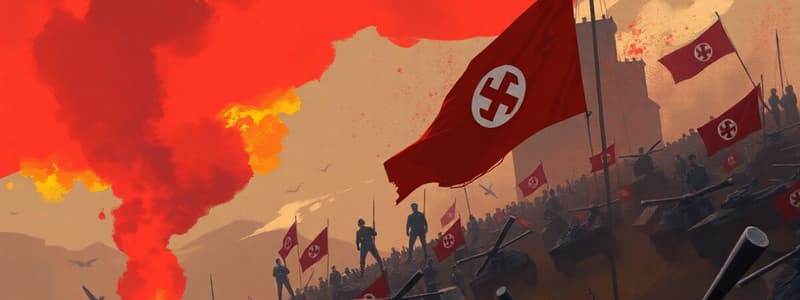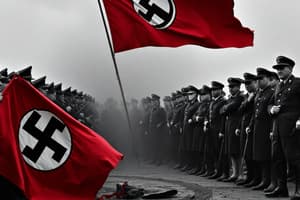Podcast
Questions and Answers
Which of the following events is NOT considered a turning point in World War II?
Which of the following events is NOT considered a turning point in World War II?
- The Battle of the Bulge
- The Invasion of Italy
- The Lend-Lease Act (correct)
- The Battle of Midway
What was the purpose of the Manhattan Project?
What was the purpose of the Manhattan Project?
- To establish a strategic military base in the Pacific Ocean
- To create a new type of aircraft engine
- To develop a new type of radar system
- To develop the atomic bomb (correct)
Which of the following terms is closely associated with the concept of appeasement?
Which of the following terms is closely associated with the concept of appeasement?
- Neutrality
- Lend-Lease Act
- Kamikaze
- Blitzkrieg (correct)
What was the main objective of the Yalta Conference?
What was the main objective of the Yalta Conference?
Which of these events was directly caused by the USA's decision to implement an embargo on Japan?
Which of these events was directly caused by the USA's decision to implement an embargo on Japan?
What was the primary purpose of the "Double V" campaign?
What was the primary purpose of the "Double V" campaign?
What was the significance of the Battle of Midway in World War II?
What was the significance of the Battle of Midway in World War II?
Which of the following was NOT a factor that contributed to the rise of totalitarian regimes in Europe?
Which of the following was NOT a factor that contributed to the rise of totalitarian regimes in Europe?
How did the "Rosie the Riveter" campaign impact American society during World War II?
How did the "Rosie the Riveter" campaign impact American society during World War II?
Which of the following accurately describes the Lend-Lease Act's impact on the course of World War II?
Which of the following accurately describes the Lend-Lease Act's impact on the course of World War II?
What was the main goal of the 'Double V' campaign?
What was the main goal of the 'Double V' campaign?
Which of the following events is considered a significant turning point in the Pacific Theater of World War II?
Which of the following events is considered a significant turning point in the Pacific Theater of World War II?
What was the primary factor that led to the implementation of Executive Order 9066?
What was the primary factor that led to the implementation of Executive Order 9066?
Which of the following describes a strategic military tactic employed by the Japanese during World War II?
Which of the following describes a strategic military tactic employed by the Japanese during World War II?
What was the significance of the Yalta Conference in terms of post-war Europe?
What was the significance of the Yalta Conference in terms of post-war Europe?
What was the primary goal of the Office of War Mobilization?
What was the primary goal of the Office of War Mobilization?
How did the 'Rosie the Riveter' campaign contribute to the war effort?
How did the 'Rosie the Riveter' campaign contribute to the war effort?
Why was the development and use of the atomic bomb such a controversial decision?
Why was the development and use of the atomic bomb such a controversial decision?
Flashcards
Totalitarianism
Totalitarianism
A political system where the state holds total control over all aspects of public and private life, suppressing opposition and individual liberties.
Holocaust
Holocaust
The systematic, state-sponsored persecution and murder of six million Jews and millions of other people by Nazi Germany and its collaborators during World War II.
Blitzkrieg
Blitzkrieg
A strategy of military conquest characterized by rapid, overwhelming attacks using combined air and ground forces.
Appeasement
Appeasement
Signup and view all the flashcards
Neutrality
Neutrality
Signup and view all the flashcards
Lend-Lease Act
Lend-Lease Act
Signup and view all the flashcards
Turning Point in the Pacific
Turning Point in the Pacific
Signup and view all the flashcards
Yalta Conference
Yalta Conference
Signup and view all the flashcards
Mein Kampf
Mein Kampf
Signup and view all the flashcards
MINT
MINT
Signup and view all the flashcards
Atlantic Charter
Atlantic Charter
Signup and view all the flashcards
Home Front
Home Front
Signup and view all the flashcards
Double V Campaign
Double V Campaign
Signup and view all the flashcards
Study Notes
World War II: Key Concepts and Events
- Totalitarian Regimes and Control: Dictatorships and totalitarian governments exerted extreme control over citizens' lives.
- Hitler and Mein Kampf: Hitler's ideology, as outlined in Mein Kampf, played a pivotal role in the rise of Nazi Germany and its aggressive expansionist policies.
- MINT (Militarism, Imperialism, Nationalism, & Totalitarianism): These factors contributed to the rise of aggressive nationalism and fueled the conflicts leading up to World War II.
- Appeasement: Attempts by European powers to avoid conflict with Hitler's Germany by making concessions.
- Neutrality: The policy of some nations to remain uninvolved in the international conflicts of the 1930s and early 1940s.
- Lend-Lease Act: The US provided critical support to Allied nations by transferring defense supplies and financial aid, allowing FDR to transfer defense equipment and other forms of aid, including money, to Allied nations “vital to the defense of democracy.”
- Atlantic Charter: A joint declaration by the US and UK outlining shared goals for the post-war world.
- Pearl Harbor and Embargo: The Japanese attack on Pearl Harbor and subsequent economic sanctions (embargoes) were major events that led the US into World War II. The story of Pearl Harbor and the embargo is a key event in determining US intervention.
- Poland and Blitzkrieg: Nazi Germany’s invasion of Poland initiated World War II, utilizing the tactic of blitzkrieg (lightning warfare). Poland is the country that started the war.
Home Front
- War Mobilization and Cost-Plus Contracts: The US government implemented measures to mobilize the economy for war effort, including innovative cost-plus contracts run by the Office of War Mobilization.
- Rosie the Riveter: A symbol representing women's significant contributions to the war effort in industrial labor roles.
- Rationing and Coupon Books: Government-imposed restrictions on the consumption of essential goods in the US.
- Executive Order 9066 and Korematsu v. US: Forced relocation and internment of Japanese Americans during World War II, which was later deemed unconstitutional in Korematsu v. US. The government ordered Executive Order 9066 due to perceived wartime security risks.
- Bracero Program, Zoot Suit Riots, Navajo Code Talkers: These represent different facets of the American home front during WWII. The Bracero Program brought in Mexican laborers to meet agricultural needs; tensions between Mexican-American youth and authorities were seen in Zoot Suit Riots, while Navajo Code Talkers played an essential role in communications.
- Double V Campaign: This campaign highlighted the African American fight for both victory abroad and racial equality at home during WWII.
Early Stages of the War
- Turning Point for Hitler: Key events and battles marked turning points in the war.
- Sonar and Convoys: Technology and strategic deployments played a crucial role, like sonar which improved detection and convoy strategies.
- Bataan Death March: A brutal forced march of Allied prisoners of war by the Japanese military.
- Midway: A crucial naval battle in the Pacific during World War II, considered a major turning point. Midway, a key area, marks a turning point in the Pacific theater.
Allies' Advance
- Invasion of Italy: The Allies’ operations to liberate Italy from Axis control.
- D-Day: Allied forces' successful invasion of Normandy, France, a major turning point in the European theater.
- Battle of the Bulge: A significant German counter-offensive in the Western Front, stalled the allied advance but was unsuccessful.
Conclusion of the War
- V-E Day: The end of the war in Europe.
- Kamikaze Pilots and Island Hopping: The Japanese strategy of suicidal attacks and methodical island conquest in the Pacific Theatre.
- Iwo Jima and Okinawa: Fierce and costly battles on these Pacific islands, ultimately leading to the decision to use the atomic bomb.
- Pros and Cons of Atomic Bombs: The use of atomic bombs on Hiroshima and Nagasaki hastened the end of the war, potentially saving American lives by avoiding a land invasion, justified the cost of the Manhattan Project, and also intimidated Russia. However, it caused immense suffering.
- Manhattan Project: Secret US project to develop the atomic bomb.
- Holocaust: State-sponsored genocide during WWII that targeted Jews and other minority groups.
- Post-War Occupation of Germany: Germany was divided into occupation zones by the Allied Powers: Great Britain, the US, Russia, and France each controlled a zone of Germany in an attempt to rebuild the German country.
- Yalta Conference: A meeting where Allied forces decided on the unconditional surrender of Germany and Japan resulting in agreements of unconditional surrender of both Germany & Japan.
Studying That Suits You
Use AI to generate personalized quizzes and flashcards to suit your learning preferences.
Description
Test your knowledge on the critical concepts and events of World War II. This quiz covers totalitarian regimes, Hitler's ideologies, and key policies like the Lend-Lease Act and the Atlantic Charter. Understand the factors leading up to the war and significant decisions made by nations during this tumultuous period.




